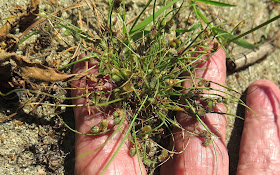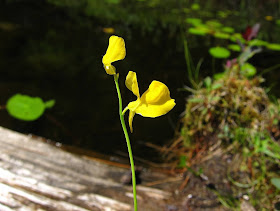Oh gosh, the summer days are dwindling down fast! As September looms, I feel some urgency to visit my favorite nature haunts and record what makes each site remarkable. That kept me running last week, but now it's time to sit down, unload my camera's memory card, and file some reports before I set off again this week for more adventures. So here's just a digest of some of the finds I encountered recently.
Rockwell Falls at Lake Luzerne
Here, where the Hudson River narrows to plunge through a gorge below Rockwell Falls, the rocky shore and gravelly bars come alive with late-season flowers. I managed to teeter along over jumbled boulders and wade out into the shallows to see what's blooming there this week. The first flower I encountered was the bright-yellow Sneezeweed (
Helenium autunmale). A small green bee was investigating its abundant pollen supply.
You sure can't miss the brilliant Cardinal Flower (
Lobelia cardenalis) blazing away amid the riverside greenery.
But the flowers of Creeping Spearwort (Ranunculus reptans) are so tiny you might miss them if you didn't lean down to discover them sprawling across the gravelly shore on their slender creeping stems.
Golden Pert (
Gratiola aurea) is another small yellow flower, but because it blooms in great masses that thickly carpet the mudflats and gravel bars, you can't fail to miss the golden glow of its myriad blooms.
* * *
Fourth Lake, near the Village of Lake Luzerne
A state campground provided us access to this small quiet lake a few miles north of the village of Lake Luzerne, and my friends Sue and Ruth and I had it all to ourselves as we set out to paddle its shores. We started at the north end of the lake, where hundreds, nay thousands of snow-white Fragrant Water Lilies (Nymphaea odorata) dotted the dark still water.
Have you ever wondered why you never see a fading Water Lily, one with its pristine white petals either wilting or turning brown? That's because as soon as the flower is pollinated, its stem sharply retracts to deposit the fertilized ovary into the mud at the bottom of the pond, there to produce a new plant. So the ones we do see floating so serenely on the surface are always "perfectly perfect!"
We ourselves were pondering another mystery regarding the Water Lilies and the Yellow Pond Lilies (
Nuphar variegata). As we moved among the floating pads, we kept hearing
pop! pop!, as if the plants were announcing our presence to one another. Well, thanks to the portable computers we now carry in our pockets, we soon learned that the sound was produced by underwater fish sucking aquatic insects off the undersides of the lily pads, creating a suction and causing the pad to respond with a pop when the suction broke the leaf. Wow! Learn something new every day! Here's the site where we learned this fascinating fact:
https://askanaturalist.com/what-is-that-popping-noise-in-the-lily-pads/
The shoreline was thick with emergent flowering plants like this Pickerelweed (
Pontederia cordata), which looked especially impressive when backlit against the dark shade of the surrounding forest.
The single most abundant shoreline plant, however, was the pink-flowered Water Loosestrife (
Decodon verticillatus), a native wetland species. Bearing brightly colored blooms that wreathe the leaf axils, the arching stems bent gracefully over the water.
Near the south end of the lake we encountered a vast mat of brown underwater tangles. We spotted a few small purple flowers dotting the mat, and a closer look revealed the blooms of Purple Bladderwort (
Utricularia purpurea).
Probably the strangest sight we encountered on Fourth Lake were large underwater gelatinous masses that had formed on fallen logs and branches. Referred to as "moss animals" (
Bryozoans), the masses were formed by colonies of filter-feeding organisms called
Pectinatella magnifica. We had found these colonies before in other water bodies, but never in the quantities that we found in this little lake.
Our mutual friend Evelyn Greene had asked us to be on the lookout for an underwater plant that she described as "black and wiry." Well, I would describe this darkish milfoil as "feathery" rather than wiry, but I went ahead and extracted a piece of one and sent a photo of it to Evelyn, who told me, "That's it!" The "it" she meant was Farwell's Water Milfoil (
Myriophyllum farwelii), rated as a Threatened species in New York State. Unfortunately, a flower or fruit would be required to positively identify this as the Farwell's species, and I can see neither flower nor fruit on the piece I collected. I guess that means we shall have to return to Fourth Lake to hunt for a more "fruitful" specimen! It has been documented as present in this lake.
Bog Meadow Brook Nature Trail, Saratoga Springs
I had just an hour or so free on one day this past week, so the Bog Meadow Brook Nature Trail just outside of town seemed a good destination for a quick walk. I entered the trail about mid-length through a spur that accesses the main trail via a boardwalk across a deeply shaded forested wetland.
I did not expect to see any brightly colored flowers this late in summer, especially among the gloom of this thickly forested swamp. But the vivid pinky-purple flowers of a large patch of Swamp Thistle (Cirsium muticum) blooming well off the trail caught my eye and beckoned me to approach for a better view.
This gorgeous native thistle not only has beautiful flowers, but the cup-shaped bases of the flowers (called involucres) are also attractive. They look as if they were ornamentally beaded, bearing dark-green, white-striped bracts that are interwoven with fine webby hairs. The webby hairs on the involucres are a distinguishing feature of this thistle.
While I stood admiring this patch of about 10 thistles, each plant towering to around 7 feet tall, this enormous and beautiful butterfly came wafting in, quickly fluttering from flower to flower as if tasting just a sip of the nectar of each bloom.
This is the Giant Swallowtail Butterfly, a more southern species that has become more abundant up north in recent years. Although the adult can feed on any nectar-producing flower, its larvae can feed only on leaves of the citrus family. We don't have orange or lemon trees up here, but we do have several member of the citrus family, Northern Prickly Ash and Wafer Ash among them.
I was hoping I might find some Downy Rattlesnake Plantain orchids (Goodyera pubescens) still blooming along this trail, and I did. A nice patch of them, in fact. Although their flowers were mostly spent, I still enjoyed seeing their beautifully patterned evergreen leaves. And I was delighted to see that they HAD had blooms. In many years, I can find the leaves looking gorgeous and healthy, but without any flower stalks emerging among them.
In May, I find many Red Trillium (
Trillium erectum) blooming along this trail, but I don't often find their glossy red fruits in late summer. Today was my lucky day.
Today was a good day, too, for finding some colorful fungi. The most abundant species was this bright-yellow, brown-edged mushroom called Chicken-fat Suillus (
Suillus americanus). I imagine it acquired that odd common name because its color resembles that of good
schmaltz. It also has a rather slimy texture, a characteristic that suggested one of its other common names, Slippery Jack. My own name for it would have been Lemon Pie.
And wow! What a gorgeous cluster of vivid orange mushrooms! This is Orange Mycena (
Mycena leaiana), a relatively common fungus always found thickly clustered on rotting wood.
The Spring Run Trail, Saratoga Springs
For an even briefer walk this week I chose the Spring Run Trail, just a few blocks from my home in downtown Saratoga Springs. This mile-long trail follows the route of a now-defunct railway line, passing through forest and cattail marsh and often within the sound of rushing water from the nearby Spring Run Creek. The developer of a nearby commercial/residential complex has created a boardwalk across the swamp near the eastern terminus of the trail. I entered the main trail by crossing this very welcome boardwalk.
As is unfortunately the case for disturbed soils along old railway lines, invasive species like non-native honeysuckle shrubs line the trail, and the equally invasive Purple Loosestrife thrives in the swampy areas. But some of our native wildflowers soldier on, like this abundant clump of Spotted Joe-Pye Weed (Eutrochium maculatum) asserting its rightful place in the swamp. The surrounding cattails and jewelweeds, native species both, also maintain their foothold against the invaders that press from every side.
Happily, one of our most gorgeous native wildflowers, the Great Lobelia (
Lobelia syphilitica) has found a happy spot along this trail, abounding in generous numbers near where a bridge crosses the creek, the population extending along a damp trailside drainage ditch. I can forgive all the invasive species that crowd this trail, so long as this beautiful royal-blue flower continues to thrive at this easily accessible site. As it has for many years. Long may it be so!




















































